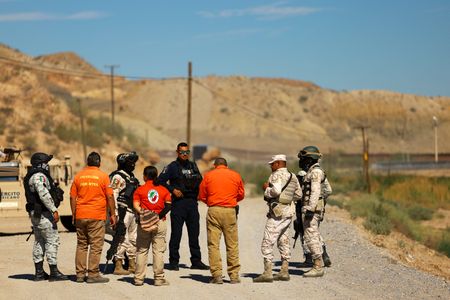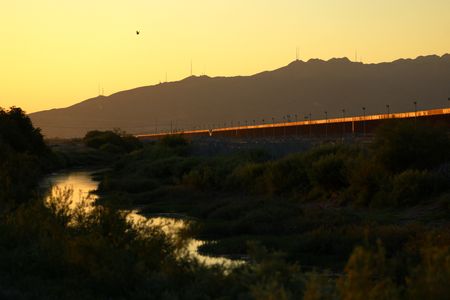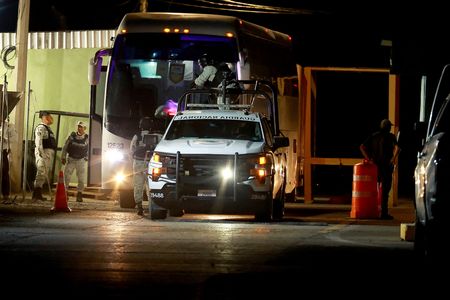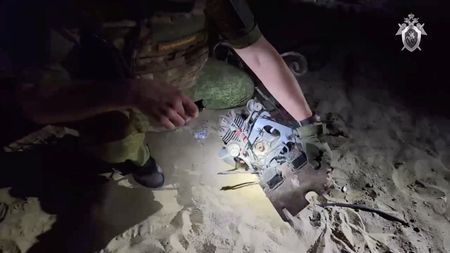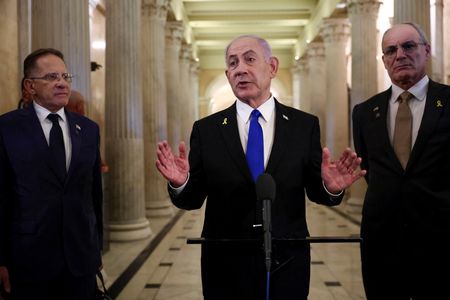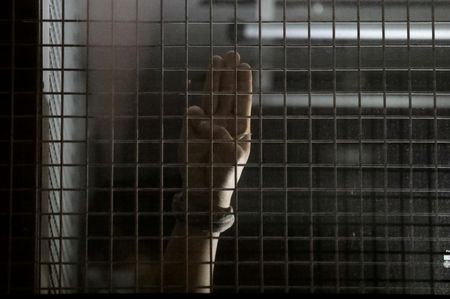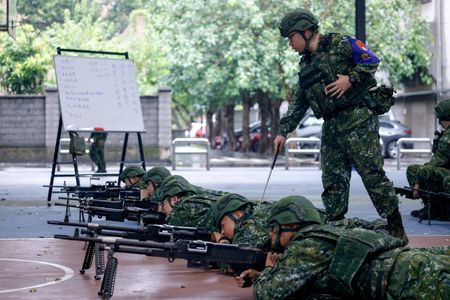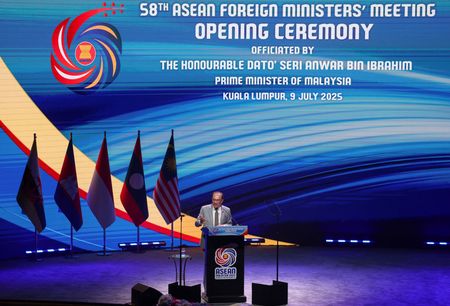By Diego Oré, Laura Gottesdiener, Ted Hesson and Jose Luis Gonzalez
CIUDAD JUAREZ, Mexico (Reuters) – At a remote military checkpoint in the Mexican desert some 25 miles (40 km) south of the border city of Ciudad Juarez, immigration agents bundled dozens of migrants onto a bus headed south on a hot night in September.
Hundreds of scenes like this one, witnessed on Sept.
24 by a Reuters reporter, form part of Mexico’s largest ever migration crackdown.
The crackdown encompasses a growing program to bus and fly non-Mexican migrants to the country’s south, far from the U.S.
border, along with widespread detentions and administrative obstacles, according to public data and conversations with a dozen U.S. and Mexican officials.
Partly as a result of Mexico’s efforts, the number of migrants caught by U.S.
authorities at the border in recent months fell sharply to the lowest level since 2020, taking some heat out of an issue on which, polls show, voters trust Republican candidate Donald Trump more than his Democratic rival, Vice President Kamala Harris ahead of the Nov.
5 U.S. presidential election.
“A border perceived to be out of control is fuel for Donald Trump,” said Justin Gest, an immigration expert and professor at George Mason University. Mexico’s crackdown helps the Biden administration throw “water over that fire,” he said.
Collectively, the measures aim to tire migrants so they give up before reaching U.S.
territory, five Mexican officials told Reuters. Mexico is on track to bus a third more migrants to its southern states this year, previously unreported data shows.
Venezuelan Jose Díaz was detained by migration agents in the northern border city of Tijuana and then taken by bus over 2,000 miles (3,500 km) to the southern city of Villahermosa, over a three-day journey early in September.
“They send you back and then you have to head north all over again,” he said.
The officials asked not to be named to discuss measures that contrast with the Mexican government’s stated humanitarian migration policy.
In response to Reuters questions, Mexico’s foreign ministry said the goal was to protect migrants from human traffickers, not exhaust them.
Now in its tenth month, the crackdown followed pressure from the United States, the Mexican officials told Reuters, including the temporary closure in December of several trade routes into Mexico at an estimated daily cost of $100 million, and explicit requests by U.S.
officials in private meetings and in a phone call between President Joe Biden and his Mexican counterpart.
Harris has used the U.S. numbers to argue in her campaign that the Biden administration has been tough on border issues.
While Trump has increasingly turned toward darker and more violent language about immigrants, Mexico itself has been less of a target than in his 2016 campaign.
That is the point of the crackdown, one senior Mexican official said: Mexico is determined not to be the focus of the election.
Newly inaugurated Mexican President Claudia Sheinbaum has said she will work closely with whoever wins the White House, and the foreign ministry said the country’s migration strategy was unrelated to the election.
Sheinbaum’s office did not reply to a request for comment.
The Harris campaign declined to comment. The Trump campaign did not respond to requests for comment.
In response to Reuters questions to the White House, a senior official said Mexico acted in its own interests, adding that both sides made “a joint effort to address” the issue.
The official requested anonymity as a condition of the interview.
PRESSURE
Starting in late November last year, the United States experienced a spike in border apprehensions, after the Mexican government suspended busing and flying of migrants, citing a funding crunch.
In response, the Biden administration closed several commercial border ports, including busy Texas railway bridges in El Paso and Eagle Pass on Dec.
18, citing the need to redirect personnel to process migrants.
One former senior U.S. Customs and Border Protection official who served under Trump said no such lengthy closures occurred under the former president, despite his repeated threats to shut the border over immigration.
The cost to Mexican companies, around $100 million per day in lost trade according to business lobby Coparmex, dwarfs the $158 million that internal government documents seen by Reuters show Mexico allocated to internal busing and flying of migrants over the previous four years.
On Dec.
22, the day after a call between President Joe Biden and Mexican President Andres Manuel Lopez Obrador and with a visit by U.S. Secretary of State Antony Blinken looming on Dec. 27, the Mexican president said the country had a plan to “strengthen” its migration program.
The buses quickly reappeared, carrying more migrants than before.
The bridge closures were an operational necessity that had the additional benefit of pressuring Mexico, three current and former U.S.
officials told Reuters.
It “certainly got Mexico’s attention,” a senior State Department official said.
The move put Mexico “between a rock and a hard place” said one Mexican official, who along with two others said they understood it as a way to force the government’s hand.
Mexico’s foreign ministry, in its response to Reuters questions, said the closures responded mainly to U.S.
internal security and were not aimed “specifically at pressuring Mexico.”
In the meetings with Blinken and on a subsequent call with Biden, Mexico offered to do more, the five Mexican government officials said.
In January, Mexico increased checkpoints on highways and railroads heading north.
Starting in March, Mexico’s National Migration Institute, INM, allocated $30 million for local low-cost airline Viva Aerobus to operate migrant flights in 2024, almost triple the amount allocated to the company in 2023, government documents seen by Reuters show.
INM allocated around $5 million for migrant transport each year in 2023 and 2024 to airline Magnicharters, the documents showed.
Roberto Alcantara, the owner of Viva Aerobus, also owns coach company Turistar, which INM paid more than $65 million since last year for the busing program, government documents show.
Alcantara, Viva Aerobus, Magnicharters and Turistar did not respond to requests for comment.
INM did not reply to questions about the contracts.
Reuters could not establish if other companies had similar contracts.
Mexico’s foreign ministry said the United States does not fund Mexico’s migration program.
The Biden administration’s broad asylum ban implemented in early June has contributed to decreasing U.S.
apprehensions, U.S. officials have said. With U.S. funding, Panama in August started regular deportation flights for migrants caught crossing the dangerous Darien jungle, part of U.S. efforts across Central America to keep migrants from reaching Mexico.
Nonetheless, Mexico’s effort has been “absolutely crucial,” for lowering U.S.
migrant apprehensions, said Wayne Cornelius, director emeritus of the Mexican Migration Field Research Program at the University of California-San Diego. His comments were echoed by the U.S. and Mexican officials.
At the same time as it increased busing, Mexico slowed immigration and asylum processing.
Public data shows a 97% drop this year in issuance of humanitarian visitor cards, a key document migrants use to avoid detentions.
INM permanently closed 10 offices where migrants apply for this document this year, two of the sources said.
Refugee applications dropped by half in the first nine months of the year compared to the same period a year earlier, public data shows.
These steps were deliberate measures to make it harder for migrants to traverse the country, three of the Mexican sources said.
INM did not respond to a question about the administrative measures.
BUSES
As they boarded the white commercial coach witnessed by Reuters at the Samalayuca military checkpoint near Ciudad Juarez in September, at least one of the migrants had their hands cuffed with parcel ties, Reuters photographs show.
The bus was headed to the city of Monterrey, some 700 miles (1,100 km) to the southeast, and from there the migrants were to be flown further south, a source with knowledge of the operation told Reuters.
The news agency could not independently confirm the destination of the bus.
In response to Reuters questions, INM said it carries out immigration control actions “by air, sea and land,” It did not answer questions about the number of migrants, their nationalities, the bus’ destination or custody conditions, including why a man was cuffed.
Mexico’s government calls migrant detentions “rescues” that save people from smugglers.
It rarely talks about the busing program in public comments.
However, Ana Saiz, head of the legal advisory unit at Mexico’s public defender’s office, which advises migrants and Mexican citizens, called busing an “illegal practice.” She and other legal experts cited cases where migrants were transported without any record of their detention until reaching the destination in the south, and violations of immigration and custody rules, including consular access.
“There was no communication, no documents, nothing,” said Milka, a Tanzanian migrant, picked up by immigration agents in the northern state of Sonora and transported some 1,500 miles (2,400 km) south to Villahermosa.
(Editing by Frank Jack Daniel)

